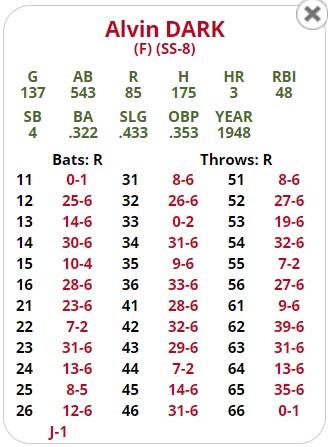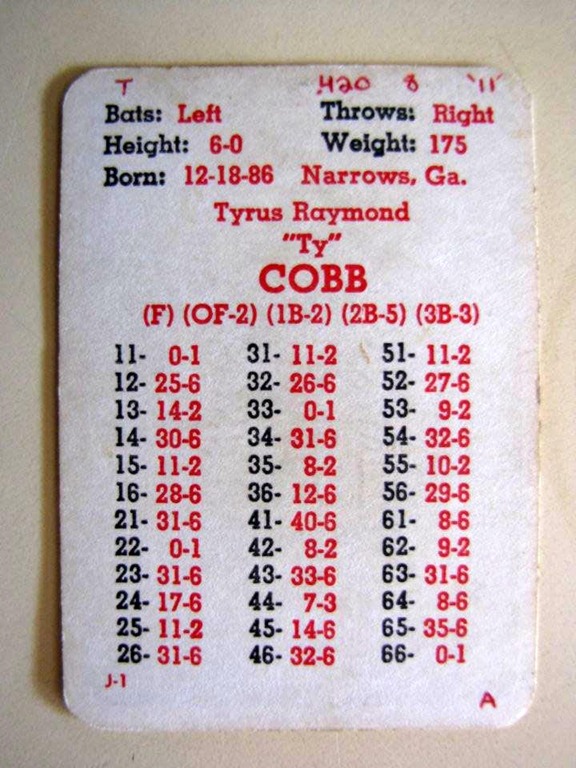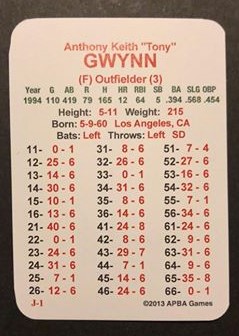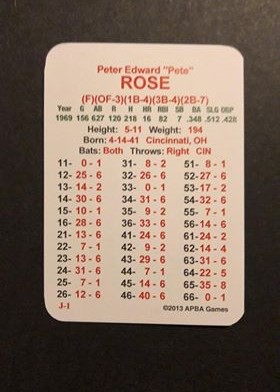
I remember when I was a kid and had been playing APBA for a few years and wondered, “What’s the big deal with the 31s?”. I was reading an article from the APBA Journal and the author was pondering how many 31s a player had. It really confused me. “It’s just a fly out, right?”, I thought to myself.
Well, I wised up after my older brother clued me in how helpful they truly are. Long story short… the 31s are turned into hits with the Hit and Run play called. I’d like to make sure everyone who plays APBA Baseball has an idea of what’s in store for when the H&R is called in the game.
The hit and run is a fun feature that APBA has incorporated into their baseball game. So fun that some leagues and tournaments regulate the use of it. Now that the APBA Company has tempered the offensive production as a result of it in the most recent version of the charts, regulation is most likely not necessary.
Anyway, let’s take a look at the Hit and Run and how to leverage it in the game of APBA Baseball. But first, what exactly is the hit and run play in real life baseball?
From the Baseball-Reference.com Bullpen:
With a runner on first base, the strategy calls for the runner to break towards second base with the pitch and for the batter to swing at the pitch, no matter where it is, in order to put the ball in play.
The runner’s break for second base, as on a stolen base attempt, means that one of the infielders has to cover the bag. This opens a hole on either the right or left side of the infield, increasing the gap for a ground ball to break through to the outfield.
If the batter hits a ground ball at a fielder, the chance of turning a double play is much reduced because the runner will already be part way to second base when the ball is hit.
If the ball is hit safely, the runner will likely advance an extra base because he is already running.
If the batter swings and misses, or if the pitch is a ball, the runner is likely to be caught stealing; because a hit-and-run is not a “straight” steal attempt, the runner usually does not take as much of a jump as if he were trying to steal.
If the batter lines out, the runner will likely be caught off his base for an easy double play.
Let’s take a deep dive into the Hit and Run play in APBA.
Overview
So, given all that information, when is the best time to hit and run within APBA? What is the best type of APBA card to hit and run with? What are some of the advantages of the play? What are the drawbacks?
If you are looking to rally from behind and score a couple runs, the Hit and Run probably is not for that situation. In fact, even if you roll a 66-1, that will only garner you an RBI double. That’s right, it is impossible to hit a home run using the Hit and Run. If you are looking to score one run or perhaps move the runner along, this play might be the one for you.
Those nifty 31s!
The APBA feature we most think about when it comes to the Hit and Run play is the play result 31 on the hitter’s card. In standard play, a 31 is a fly out to center. If you hit and run, it is a successfully executed hit and run play, a base hit moving the runners two bases.

Most players’ hitting cards come equipped with one or two 31s. Most of the time, the first 31 is on the 34 and if they have a second one, it is at 63.
Those with one 31 are most likely free swingers with little bat control. The ones with two 31s can see the ball slightly better and are fair game to use with the hit and run.
On occasion, you will see those with exceptional bat control that have three or more 31s. As of recent years, no more than five players per year have received this many. Going back to past years (especially Deadball years) many more reach this status. At the top, you see Al Dark’s 1948 card with four. Ty Cobb’s 1911 card which is a Monster Card in its own right, has five 31s. No APBA card has more than that.
Runner’s steal numbers
I have seen managers (APBA and real-life) employ the hit and run with less than speedy baserunners on base. However, they tend to be outliers. The primary MO is to move the runner along and the idea is that the runner is a steal threat.
When it comes to APBA’s game engine, a runner on first with an 11 in the first column will steal safely on a 14. Otherwise, it is a Strike; runner out stealing in the first column. In addition, a 35 result number is a stolen base with a runner with an 11 or a 10 (note: it does NOT say “first column” on the 35).
On a related note: there are also plenty of opportunities for baserunners to advance an extra base if they are rated (F)ast.
Stay out of the double play!
In APBA Hit and Run, the 33 and 34 is a line-drive double play since the runner is on the move instead of a pop up on the standard boards. Most hitters who have two 31s will have a 33 or a 34 but not both. However, there are some hitters with two 31s in each set who have both a 33 and a 34. I did a rough sampling and I’ll hazard a guess of around 20%.
If you’re considering the hit and run, the extra double play might deter you.
Buying yourself an out
Speaking of double plays, the bright side to the H&R is that you can use it to avoid them as well. APBA has this built into the game. If you get a play result 24 (normally a double play with a runner on first) while calling the H&R, it is simply a ground out and the runner moves to second. So, instead of two outs and bases empty, you now have one out and a runner on second.
As we say in my league, you “buy yourself an out”.

As I was talking to Kirk and Kevin about this, they brought up Tony Gwynn’s 1994 card as a great example. It really is! Gwynn has three 31s and four 24s. Not only do those 31s turn into hits but the damage done by those four 24s is minimal.
General Tips and info about the H&R in APBA
Kirk, Kevin and I all feel that generally speaking, sluggers don’t lend themselves well as good hitters in the hit and run play. They strike out more and of course, their power numbers (especially the 1!) are less helpful.

I generally am more willing to hit and run against a pitcher with control (a Z) especially if the batter has several 14s. If I know that my 14 is already going to advance the runner with a walk using the standard boards, I will be less likely to use the H&R to get that steal.
We all felt that using the hit and run play with runners on first and third does not prove to be as productive. For one, the steal numbers of the baserunners do not affect the baserunning results as significantly.
It’s worth mentioning that with runners on first and third, a Grade B pitcher stops 8s from being hits, unlike the standard boards. Rather, the 9s become hits. This is traditionally how it is done on most standard boards but the first and third board switches it around EXCEPT for the Hit and Run chart.
One piece of trivia: the H&R with First and Third chart is one of only two instances with a runner on first that a 25 does not result in a double play. In fact, the 25 will advance the runner to second base.
Further trivia: If you’re interested, a 25 on the bunt chart with First and Third is also not a DP.
The First and Third chart is so weird.
Finally, if you are playing teams of the past, do some research on the use of the hit and run. Those replaying Deadball teams and seasons will see a different way of playing the game with the hit and run.
I want to hear from you. How do you use the hit and run in APBA?




Back in the olden days people used to put a hitter with an “11” in the 8 spot in the lineup, so if he would get on 1st you could hit & run with the pitcher up (a pitcher’s card usually having lots of 13’s…which would result in a SB.)
Thomas, in the current booklet with a hit and run with runner on 1st only, the “35” result does NOT say the 11 or 10 has to be in the first column. Because they go to the trouble to point out that it has to be first column on a “14” result, I take it as face value on the 35. If the runner has only second column “11” ‘s, I read that as the base is stolen.
In my cards and dice league, because i’m an old schooler and can’t stand all the strikeouts in today’s version of baseball, i have my roster loaded heavily towards hitters that don’t strike out a lot, and i hit and run several times a game(but seems like i line into DP’s almost half the time,or get the 13 still). I drafted free agent/rookie Hanser Alberto of Baltimore this year for his 3 31’s and he bats #2 in my order. Sweeet
Erik,
You are totally correct. Thanks for the catch!
It reads: 35–Strike; runner out stealing; A-C PO-2B IF RUNNER HAS A TEN OR ELEVEN ON CARD, HE STEALS SAFELY
I agree with your assessment that since the ’14’ specifies “first column”, it could refer to ANY 11 on the card.
thanks again!
Tom
I would disagree with the 14 result assessment. My interpretation of the 35 and 14 results are for the result only. I do not apply the 14 result that the 11 can be anywhere from dice result 35 on the card it must be only in the first column only. To use a player as an example is Chipper Jones and his 1998 card. He has a 10 in the first column and 11’s in the second column only. If you played hit and run with him on first rolled the dice result of 35 he would steal second. The dice result 14 he would be out stealing. I like the newer basic games boards because with the older boards it was almost impossible to prevent a player with an 11 on the card from stealing second when playing hit and run. It slows down the overuse of hit and run in my opinion.
Hi Phil,
with the old boards, our league stipulated that the batter must have at least two 31s to hit and run.
Tom
I used to love using the hit and run, but the current charts have completely destroyed this tool. Even playing deadball era games the steals are greatly reduced.
The first and third hit and run is exceptionally dangerous to use. Not only is there ZERO opportunities for a stolen base, there is a hit by pitch where the batter is injured based on their “error number”. You couldn’t PAY me to use the first and third chart.
I find most of my steals now come from the 11’s and 10’s directly. I still use the runner on first very much, but I would gather about 10% of my steals come from the 14 and 5% from the 35 when using it. Otherwise it’s like asking “can you please throw out my runner?”
Really enjoy these 101 blogs! I would love to read about what you look for when you first see a card to get a sense for how good it is, or the different quirks that you can pick out based on different numbers. I’m relatively new, so a crash course would be awesome! Thank you!
Thanks, Brett! I appreciate the feedback! The idea came about when Kevin, Kirk and I were brainstorming on Zoom. I give Kirk credit for the “APBA 101” name. I think all three of us will be doing this.
I like your idea. Maybe we’ll be doing one like it soon!
Back when I used to play with the cards (late 1970’s) I loved using the hit and run. Back then, and 13 OR a 14 would result in a steal for a player with an 11, and a 14 would result in a steal for a player with a 10. It was the only way a MANAGER could call for a steal.
Nowadays I play (solo) BBW, but still hit and run a lot. But now it seems like I hit the “groundout to pitcher” all the time. :)
So, are the newer cards and reprints adjusted to the new boards, and especially to the less advantageous Hit n Run results? And are my original cards for 1970 and 1980 teams compromised somehow with the more stringent ‘newer’ boards? I feel like the neeer boards are better but I may have to add an ‘*’ to a few base stealers (Lopes, Leflore, Brock, Moreno) who won’t get as many SBs now that I’m not using Hit n Run anymore
It depends on what you are playing … a tournament? You do what has to be done for every run. In tournament play, I hit & run only when the pitcher has a Z. I make sure the H&R play gives me a better chance at having a better at bat. I count all the dice rolls that result in a better play and also in a worse play. if the better play dice rolls are greater than, well I H&R but I don’t always loo for the stolen base.